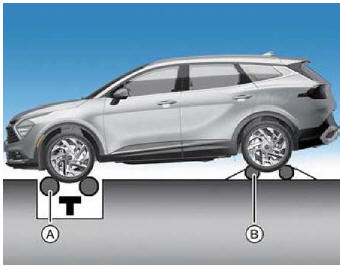Kia Sportage: Transmission overheated

- Transmission Hot! Park with engine
on
- Trans cooled. Resume driving
- When driving on muddy and sandy roads under the severe condition, the transmission could be overheated.
- When the transmission is overheated, the safe protection mode engages and the "Transmission Hot! Park with engine on" warning message will appear on the LCD display with a chime.
- If this occurs, pull over to a safe location, stop the vehicle with the engine running, apply the brakes and shift the vehicle to P (Park), and allow the transmission to cool.
- If you ignore this warning, the driving condition may become worse. You may experience abrupt shifts, frequent shifts, or jerkiness. To return to the normal driving condition, stop the vehicle and apply the foot brake or shift into P (Park). Then allow the transmission to cool for a few minutes with engine on, before driving off.
- When the message "Trans cooled.
Resume driving" appears you can continue to drive your vehicle.
If the warning messages in the LCD display continue to blink, for your safety, have the system checked by an authorized Kia dealer.
Tire precautions
Always pay attention to tires for AWD (all-wheel drive) vehicles.
When driving in all-wheel drive, driving force is applied to all tires, and the driving performance of the vehicle is greatly affected by the degree of tire wear:
- When replacing tires, be sure to equip
all four tires with the same size, type,
tread, brand and load-carrying capacity.
Do not use tire and wheel with different size and type from the one originally installed on your vehicle. It can affect the safety and performance of your vehicle, which could lead to steering failure or rollover causing serious injury.
- Replace the front and rear tire positions every 8 , 0 0 0 miles (13,000 km).
- Each tire should be checked monthly when cold and inflated to inflation pressure recommended by the vehicle manufacturer on the vehicle placard or tire inflation pressure label.
- For AWD (all-wheel drive) vehicles,
install the chains on the front wheels.
However, this may damage the AWD system, so keep the travel distance as short as possible.
* Refer to "Tire chains"
Towing precautions


AWD vehicle

FWD vehicle
The AWD vehicle should never be towed with the wheels on the ground. Your vehicle must be towed with a wheel lift and dollies or flatbed equipment with all the wheels off the ground.
* Refer to "Towing"
CAUTION
The AWD vehicle cannot be towed with sling-type equipment. Use wheel lift or flatbed equipment.
WARNING
Your vehicle is equipped with tires designed to provide safe ride and handling capability. Do not use tires and wheels that are different in size and type f r om the originally installed ones. It can affect the safety and performance of your vehicle, which could lead to steering failure or rollover and serious injury.
When replacing the tires, be sure to equip all four tires with the tire and wheel of the same size, type, tread, brand and load-carrying capacity.
WARNING
Jacked vehicle
While the full-time AWD vehicle is being raised on a jack, never start the engine or cause the tires to rotate.
There is the danger that rotating tires touching the ground could cause the vehicle to go off the jack and to jump forward.
- Full-time AWD vehicles must be tested on a special four wheel chassis dynamometer.
NOTICE
Never engage the parking brake while performing these tests.
- A full-time AWD vehicle should not be
tested on a FWD roll tester. If a FWD
roll tester must be used, perform the
following:

- Roll tester
- Temporary free roller
- Check the tire pressures recommended for your vehicle.
- Place the front wheels on the roll tester (A) for a speedometer test.
- Release the parking brake.
- Place the rear wheels on the temporary free roller (B).
WARNING
Dynamometer testing
Keep away from the front of the vehicle while the vehicle is in gear on the dynamometer.
This is very dangerous as the vehicle can j u m p forward and cause serious injury or death.
CAUTION
- When lifting up the vehicle, do not
operate front and rear wheel separately.
All four wheels should be operated.
- If you need to operate the front wheel and rear wheel when lifting up the vehicle, you should release the parking brake.
READ NEXT:
 Power brakes
Power brakes
Your vehicle has power-assisted brakes,
parking brake, and various braking systems
for safe driving.
Power brakes
Your vehicle has power-assisted brakes
that adjust automatically through normal
 Electronic Parking Brake (EPB)
Electronic Parking Brake (EPB)
After parking the vehicle, apply the Electronic
Parking Brake (EPB) to prevent
the vehicle f r om being moved by the
external force.
Applying the parking brake
Applying the parking brake with EPB
SEE MORE:
 Important - use of compact spare tire
Important - use of compact spare tire
Your vehicle is equipped with a compact
spare tire. This compact spare tire takes
up less space than a regular-size tire.
This tire is smaller than a conventional
tire and is designed for temporary use
only.
You should drive carefully when the
compact spare is in use. The compact
spar
 Cup holder
Cup holder
There are various features inside the
vehicle for the convenience of the occupants.
Cup holder
Front
Cups or small beverage cans may be
placed in the cup holders.
WARNING
Hot liquids
Do not place uncovered cups with hot
liquid in the cup holder while the vehicle
is in motion. If the hot
Content
- Home
- Kia Sportage - Fifth generation (NQ5) - (2022-2025) - Owner's Manual
- Kia Sportage - Second generation (JEKM) (2005-2015) - Body Workshop Manual
- Kia Sportage Third generation (SL) - (2011-2016) - Service and Repair Manual
- Sitemap
- Top articles